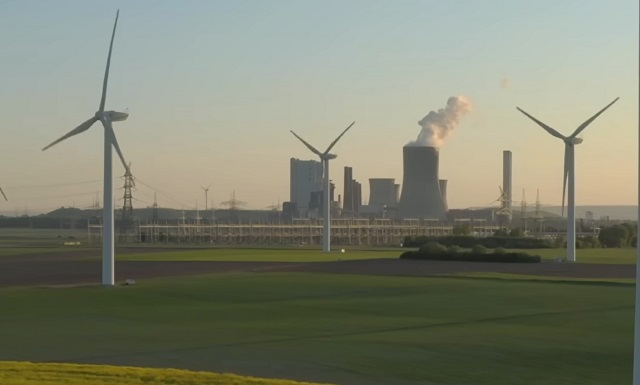Energy
Majority of Canadians Support Canada’s Role as Responsible Energy Producer & Exporter: POLL

A new poll has found that a growing number of Canadians support our country’s role as a responsible and reliable global energy producer and exporter.
According to the poll – conducted by Research Co. on behalf of Canada Action – a majority of Canadians, nearly three out of four (73% of respondents), believe Canada’s liquefied natural gas (LNG) can help improve global energy security and sustainability efforts.
The poll questioned 1,000 adults online across the country and found that most respondents have an overwhelmingly positive view of the energy sector. Other findings include:

> 80% of respondents – or four-in-five Canadians – said that given global energy demand is forecasted to grow 50% by 2050, they support trade in all Canadian energy technologies including solar, wind, hydro, hydrogen, geothermal, biofuels, and oil and gas.
> 79% of respondents – or nearly eight-in-ten Canadians – said they prefer to use Canadian energy in their day-to-day lives.
> 75% of respondents – or three-in-four Canadians – agree that exporting our responsible and reliable energy, expertise and technology to reduce global greenhouse gas (GHG) emissions is one way Canada can play an important role in addressing climate action. This is a one per cent increase since the question was asked in March.
> 73% of respondents – or nearly three-quarters of Canadians – agree that our country should advocate for Canada’s energy sector as a leader in environmentally sustainable production.
> After having been informed that from 2000 to 2019, the emission intensity of Canada’s oil sands operations dropped by approximately 33% due to technological and efficiency improvements, 73% of respondents – or almost three-in-four Canadians – agree we should advocate for Canada’s energy sector as a leader in environmentally sustainable production.
> 63% of respondents – or more than three-in-five Canadians – agree that investing in Canada’s oil and gas sector makes sense if you value climate leadership, social progress and transparency.
> 56% of respondents think its wrong for Canada to forfeit energy opportunities to other countries with higher emissions in regards to LNG – representing a rise in public support of 5% since the last poll in March 2022.
“These latest polling results confirm exactly what we’ve found in our media interviews, community events, social media engagements and public interactions over the last number of months,” said Cody Battershill, Founder and Chief Spokesperson of Canada Action.
“Canadians are coming to understand the world will need oil and gas long into the future, and so Canada should continue to play a strong role as a country that respects workers, families and Indigenous and non-Indigenous communities, and that adheres to the strictest environmental, health and safety regulations in the world,” Battershill added.
The World Needs More Canadian Resources

Canada Action’s latest poll comes amid an ongoing global energy crisis where many countries have asked us for more of what we have: natural gas, hydrogen, minerals and metals, and other critical resources.
As one of the most responsible natural resource producers on the planet, it only makes sense that we provide the world with as much of these commodities as possible while following the world-class sustainability methods and standards our country is known for.
Canada is at a crossroads: either step up to help our closest allies and trade partners in need of our resources, or lose global market share – and the economic and environmental opportunities that come with – to suppliers with fewer protections for human rights and the environment.
A majority of Canadians across the country see the benefits of more Canadian resources on global markets. It’s time our country put its full support behind developing LNG, forestry, mining, oil and other natural resource sectors to benefit our families and the global climate.
About Us
Canada Action is a non-partisan national coalition that advocates for the responsible development of Canada’s various natural resources, for the industries that move that development forward, and for the workers, families and communities the sector supports.
The poll’s margin of error, which measures sample variability, is plus or minus 3.1 percentage points, nineteen times out of twenty.
For more information: Cody Battershill – (403) 370-4008 – [email protected]
Alberta
Game changer: Trans Mountain pipeline expansion complete and starting to flow Canada’s oil to the world

Workers complete the “golden weld” of the Trans Mountain pipeline expansion on April 11, 2024 in the Fraser Valley between Hope and Chilliwack, B.C. The project saw mechanical completion on April 30, 2024. Photo courtesy Trans Mountain Corporation
From the Canadian Energy Centre
By Will Gibson
‘We’re going to be moving into a market where buyers are going to be competing to buy Canadian oil’
It is a game changer for Canada that will have ripple effects around the world.
The Trans Mountain pipeline expansion is now complete. And for the first time, global customers can access large volumes of Canadian oil, with the benefits flowing to Canada’s economy and Indigenous communities.
“We’re going to be moving into a market where buyers are going to be competing to buy Canadian oil,” BMO Capital Markets director Randy Ollenberger said recently, adding this is expected to result in a better price for Canadian oil relative to other global benchmarks.
The long-awaited expansion nearly triples capacity on the Trans Mountain system from Edmonton to the West Coast to approximately 890,000 barrels per day. Customers for the first shipments include refiners in China, California and India, according to media reports.
Shippers include all six members of the Pathways Alliance, a group of companies representing 95 per cent of oil sands production that together plan to reduce emissions from operations by 22 megatonnes by 2030 on the way to net zero by 2050.
The first tanker shipment from Trans Mountain’s expanded Westridge Marine Terminal is expected later in May.
 Photo courtesy Trans Mountain Corporation
Photo courtesy Trans Mountain Corporation
The new capacity on the Trans Mountain system comes as demand for Canadian oil from markets outside the United States is on the rise.
According to the Canada Energy Regulator, exports to destinations beyond the U.S. have averaged a record 267,000 barrels per day so far this year, up from about 130,000 barrels per day in 2020 and 33,000 barrels per day in 2017.
“Oil demand globally continues to go up,” said Phil Skolnick, New York-based oil market analyst with Eight Capital.
“Both India and China are looking to add millions of barrels a day of refining capacity through 2030.”
In India, refining demand will increase mainly for so-called medium and heavy oil like what is produced in Canada, he said.
“That’s where TMX is the opportunity for Canada, because that’s the route to get to India.”
Led by India and China, oil demand in the Asia-Pacific region is projected to increase from 36 million barrels per day in 2022 to 52 million barrels per day in 2050, according to the U.S. Energy Information Administration.
More oil coming from Canada will shake up markets for similar world oil streams including from Russia, Ecuador, and Iraq, according to analysts with Rystad Energy and Argus Media.
Expanded exports are expected to improve pricing for Canadian heavy oil, which “have been depressed for many years” in part due to pipeline shortages, according to TD Economics.
 Photo courtesy Trans Mountain Corporation
Photo courtesy Trans Mountain Corporation
In recent years, the price for oil benchmark Western Canadian Select (WCS) has hovered between $18-$20 lower than West Texas Intermediate (WTI) “to reflect these hurdles,” analyst Marc Ercolao wrote in March.
“That spread should narrow as a result of the Trans Mountain completion,” he wrote.
“Looking forward, WCS prices could conservatively close the spread by $3–4/barrel later this year, which will incentivize production and support industry profitability.”
Canada’s Parliamentary Budget Office has said that an increase of US$5 per barrel for Canadian heavy oil would add $6 billion to Canada’s economy over the course of one year.
The Trans Mountain Expansion will leave a lasting economic legacy, according to an impact assessment conducted by Ernst & Young in March 2023.
In addition to $4.9 billion in contracts with Indigenous businesses during construction, the project leaves behind more than $650 million in benefit agreements and $1.2 billion in skills training with Indigenous communities.
Ernst & Young found that between 2024 and 2043, the expanded Trans Mountain system will pay $3.7 billion in wages, generate $9.2 billion in GDP, and pay $2.8 billion in government taxes.
Energy
Market Realities Are Throwing Wrench In Biden’s Green Energy Dreams

 From the Daily Caller News Foundation
From the Daily Caller News Foundation
For two years now, I and others have been pointing out the reality that there is no real “energy transition” happening around the world. Two new items of information came to light this week that irrevocably prove the point.
It is true that governments across the western world appear to be working to bankrupt their countries by pouring trillions of debt-funded dollars, Euros and British pounds into central planning efforts to subsidize renewables and electric vehicles into existence. That reality cannot be denied. The trouble is that no amount of debt money can turn the markets and the markets aren’t cooperating.
Despite all the government largesse that has spurred major additions of wind and solar generation capacity, those weather-reliant energy sources can’t even keep up with the pace of rising demand for electricity. As a result, the markets dictated that the world consumed record levels of coal, natural gas, oil and even wood during 2023. Yes, we are still burning vast amounts of wood for electricity, despite an alleged “transition” from wood to coal which began 500 years ago.
That is reality, dictated by the markets.
Two new bits of data came to light this week that pound the final nails into the coffin of the narrative around the energy transition. A report in the Financial Times, citing data compiled by Grid Strategies, reveals that the buildout of new high-voltage transmission lines in the United States slowed to a trickle in 2023, with just 55.5 additional miles installed. That collapse comes despite the Biden government’s recognition that a massive expansion of this type of transmission lines must happen to accommodate the demands of any true “transition” to renewables.
The Financial Times quotes a 2023 assessment by the Department of Energy that found that “regional transmission must more than double and interregional transmission must grow more than fivefold by 2035 to meet decarbonization targets.” DOE admits such a pace would add more than 50,000 miles of new transmission in just 11 years, which is almost 1,000 times the pace of adds during 2023. Yikes.
A crucial aspect of that DOE study to understand is that it was conducted before we began to understand the true magnitude of additional power demands that will result from the explosive growth of AI technology just now starting to come to full bloom. It was just this past January, at the WEF Forum in Davos, where OpenAI CEO Sam Altman told the audience he believes generation capacity on the grid will have to double over the next decade just to fill the AI demands alone. That is what is needed in addition to the rising demands for EV charging, industrial growth, population growth and economic growth.
The second piece of compelling data arising this week comes from a Bloomberg story headlined, “Data Centers Now Need a Reactor’s Worth of Power, Dominion Says.” The key thing to understand about this story is that the piece is only referencing the needs of planned new data centers being built in Northern Virginia to feed AI development in that tiny sliver of the United States.
This key excerpt from the story says it all: “Over the past five years, Dominion has connected 94 data centers that, together, consume about four gigawatts of electricity, Blue said. That means that just two or three of the data center campuses now being planned could require as much electricity as all the centers Dominion hooked up since about 2019.”
That is not just rapid growth, it is exponential growth in power demand from a single developing technology.
Demand growth needs such as this aren’t going to be filled by unpredictable, unreliable, weather-dependent generation like windmills and solar arrays. And let’s face it: The United States is not going to be able to continue expanding renewables without finding some way to create a massive expansion of transmission. Why build the generation if you can’t move the electricity?
What it all means is that all the grand Biden Green New Deal plans to shut down America’s remaining coal fleet and much of its natural gas generation fleet are going to have to wait, because the market will not allow them. That’s reality, and reality does not care about anyone’s green transition dreams.
David Blackmon is an energy writer and consultant based in Texas. He spent 40 years in the oil and gas business, where he specialized in public policy and communications.
The views and opinions expressed in this commentary are those of the author and do not reflect the official position of the Daily Caller News Foundation.
-

 Brownstone Institute1 day ago
Brownstone Institute1 day agoBook Burning Goes Digital
-

 Alberta10 hours ago
Alberta10 hours agoGame changer: Trans Mountain pipeline expansion complete and starting to flow Canada’s oil to the world
-

 Addictions10 hours ago
Addictions10 hours agoCanada’s ‘safer supply’ patients are receiving staggering amounts of narcotics
-

 conflict1 day ago
conflict1 day agoOver 200 Days Into War, Family Of American Hostage in Gaza Strives For Deal To Bring Son Home
-

 Brownstone Institute18 hours ago
Brownstone Institute18 hours agoThe Predictable Wastes of Covid Relief
-

 conflict5 hours ago
conflict5 hours agoImmigration Experts Warn Possible Biden Plan To Import Gazan Refugees Would Be ‘National Security Disaster’
-

 Bruce Dowbiggin7 hours ago
Bruce Dowbiggin7 hours agoDo It Once, Shame On You; Do It Twice, Shame On Me
-

 Community7 hours ago
Community7 hours agoLast Day: What would you do with $20,000 Early Bird Prize?








